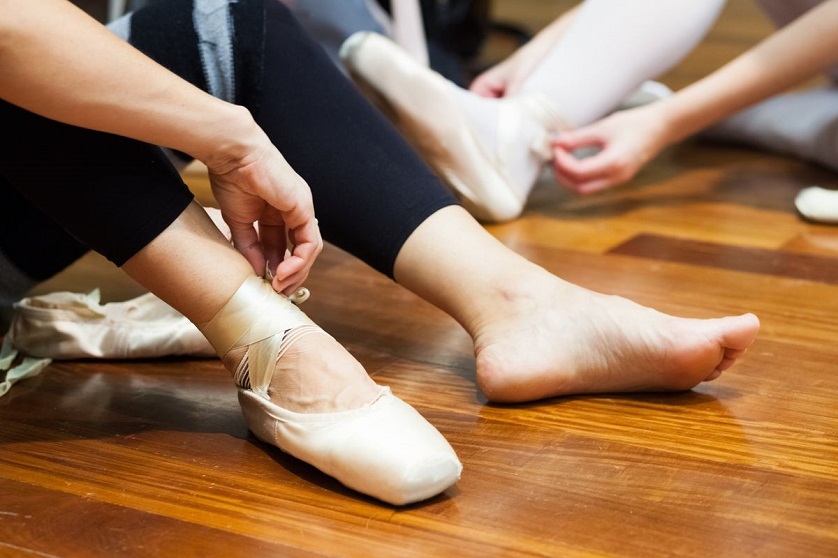Ballet is an activity that requires you to synchronise your mind and body while being extremely flexible. Choosing shoes that can help you achieve that is an essential purchase for every ballet dancer. The right shoes are the path to comfort and ability and can help you prevent injuries, pain and discomfort during a performance, learn the proper technique, or land a vital move. If you’re an experienced dancer, you might know the different dance shoe types and the dancers they’re best for. But if you (or your child) are only starting, selecting the right shoe for quick learning and outstanding performance can be challenging. Our easily-comprehensive guide can help you with that.
Contents
How Do You Choose Ballet Shoes?

Deciding between full-sole and split-sole, and finding the right fit, material, construction and colour are crucial for choosing the best ballerina shoes for you or your child.
Full-sole vs. Split-sole
Ballet shoes with a full sole have a single, continuous sole on the underside. Usually, leather, canvas, or suede make up the sole. Because it’s incredibly structured, the full-sole option can help the dancer gain strength and muscle. It provides more resistance beneath the foot’s arch. The full sole type is a good option if you are new to ballet or are searching for a durable ballet shoe.
Unlike full-sole or whole-sole ballet shoes, split-shoe ballet shoes have a split sole beneath the ball and the heel of the foot (the outer sole is not continuous). The shoe is more flexible and can highlight a dancer’s foot arch, point, and line because there is no cushioning beneath the arch. The ballet shoes with split soles are flexible, which is advantageous since this property makes it easier for the dancer to perform proper foot technique and form.
Split-sole ballet shoes, however, provide less support under the foot; for this reason, they are better suited for more experienced or skilled dancers. When doing pointe work, highly trained and experienced dancers wear pointe shoes, commonly misidentified as a specific style of ballet shoes. The box and shank at the shoe let dancers perform en pointe, which sets these shoes apart from flexible ballet shoes.
Finding the Right Fit
Whether a beginner or an experienced dancer, finding the right fit is crucial when choosing shoes for ballet, as wrong sizing can lead to pain, discomfort and bad performance. Here are a few tips to help you select the correct fit:
- Ensure to take accurate measurements of your feet. You can also ask for assistance with measurements from qualified ballet shoe professionals.
- Examine the contour of your foot and arch. Every foot is unique. Considering the dimensions, form, and feet type is very important.
- Try on various brands and styles. Some ballerina shoes employ materials that can irritate you and fit tighter than others. Try on several brands of shoes for ballet to obtain the perfect fit.
- Compare different designs. The shapes of ballet slippers might be pointed, squared, or rounded. Learn about each style to choose which one is best for you.
Material: Leather vs Canvas
Leather ballerina shoes are necessary if you’re a beginning ballet student. Canvas is less supportive than leather when you develop your foot strength. The material is thin enough to feel the floor as you dance, and it hugs your foot so your teacher can see how your foot moves. It’s the standard choice for many dancers, as the material is relatively easy to clean and strong.
Canvas gives the foot greater flexibility. Canvas ballet shoes may become more comfortable as you get more dancing expertise because they simulate dancing barefoot. Canvas is becoming more fashionable, and there are lots of shoe possibilities. The fact that canvas shoes are machine washable appeals to many dancers. But these shoes can get soiled more quickly and as such they require more frequent cleaning.
Don’t Forget About the Colour!

Particularly for female dancers, the foot is meant to carry on the leg’s line. Thus, if you exercise bare-legged or wear ballet tights, I would suggest skin-coloured shoes. If you wear white socks, I would suggest white shoes (usually guys). The gentlemen may appear more manly with black shoes on.
Extra Tips to Help You Choose Right
- Provided with all the necessary information about ballet shoes, you can ask your dance teacher to recommend a shoe style that would be best for you or your child. They know your (or your child’s) dance level the best and, therefore, can offer insight into different soles, styles and materials. They can help you with colour preference, too!
- Try the shoes first when possible, as getting the right size and fit is crucial for your future performance. If there’s a specialised dance store near you, shop in-store, so you can try the shoes before buying. If there isn’t, find a reputable online store with knowledgeable and ready-to-help staff and a convenient return policy, so you can make an exchange if the pair you choose doesn’t fit. When trying the shoes, walk around, flex and point to get a feel of their fit. They shouldn’t feel stiff but allow you to dance comfortably, providing the required support and enhancing your dance moves.
- A suitable ballerina shoe should feel like hugging your foot, conforming to its shape. A loose fit will make it harder for you to feel the floor.











